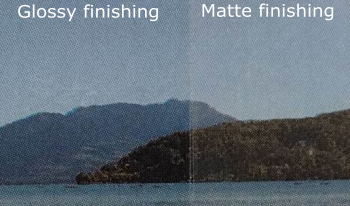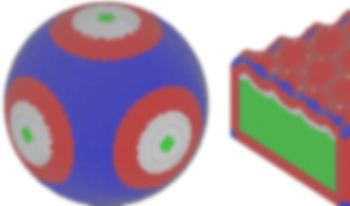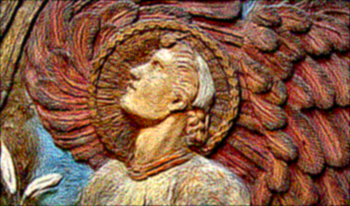
When a clear layer is coated on a diffusing background, light is reflected multiple times within the transparent layer between the background and the air-layer interface. If the background is lit in one point, the angular distribution of the scattered light and Fresnel’s angular reflectance of the interface induce a specific irradiance pattern on the diffuser: a ring-like halo. In the case where the background is not homogenously colored, e.g. a half-tone print, the multiple reflection process induces multiple con-volutions between the ring-like halo and the halftone pattern, which increases the probability for light to meet differently col-ored areas of the background and thus induces a color change of the print. This phenomenon, recently studied in the case of a smooth layer surface (glossy finishing) is extended here to rough surface layer (matte finishing) in order to see the impact of the surface roughness on the ring-like halo, and thereby on the print color change. A microfacet-based bi-directional reflectance dis-tribution function (BRDF) model is used to predict the irradi-ance pattern on the background, and physical experiments have been carried out for verification. They show that the irradiance pattern in the case of a rough surface is still a ring-like halo, and that the print color change is similar to the one observed with a smooth interface, by discarding the in-surface reflections which can induce additional color change.

Two-and-a-half and 3D printing are becoming increasingly popular, and consequently the demand for high quality surface reproduction is also increasing. Halftoning plays an important role in the quality of the surface reproduction. Three dimensional halftoning methods, that adapt the halftone structures to the geometrical structure of 3D surfaces or to the viewing direction, could further improve surface reproduction quality. In this paper, a 3D adaptive halftoning method is proposed, that incorporates different halftone structures on the same 3D surface. The halftone structures are firstly adapted to the 3D geometrical structure of the surface. Secondly, the halftone structures are adapted based on the normal vector to the surface at a specific voxel. Two simple approaches to approximate the normal vector are also proposed. The problem of edge artefacts that might occur in the previously proposed 3D Iterative Method Controlling the Dot Placement (IMCDP) halftoning method is discussed and a solution to reduce these artefacts is given. The results show that the proposed adaptive halftoning can combine different halftone structures on the same 3D surface with no transition artefacts between different halftone structures. It is also shown that using second-order frequency modulation (FM) halftone, in comparison to first-order FM, can result in more homogeneous appearance of 3D surfaces with undesirable structures on them.

Structure-aware halftoning algorithms aim at improving their non-structure-aware version by preserving high-frequency details, structures, and tones and by employing additional information from the input image content. The recently proposed achromatic structure-aware Iterative Method Controlling the Dot Placement (IMCDP) halftoning algorithm uses the angle of the dominant line in each pixel’s neighborhood as supplementary information to align halftone structures with the dominant orientation in each region and results in sharper halftones, gives a more three-dimensional impression, and improves the structural similarity and tone preservation. However, this method is developed only for monochrome halftoning, the degree of sharpness enhancement is constant for the entire image, and the algorithm is prohibitively expensive for large images. In this paper, we present a faster and more flexible approach for representing the image structure using a Gabor-based orientation extraction technique which improves the computational performance of the structure-aware IMCDP by an order of magnitude while improving the visual qualities. In addition, we extended the method to color halftoning and studied the impact of orientation information in different color channels on improving sharpness enhancement, preserving structural similarity, and decreasing color reproduction error. Furthermore, we propose a dynamic sharpness enhancement approach, which adaptively varies the local sharpness of the halftone image based on different textures across the image. Our contributions in the present work enable the algorithm to adaptively work on large images with multiple regions and different textures.

Structure-aware halftoning algorithms aim at improving their non-structure-aware version by preserving high-frequency details, structures, and tones and by employing additional information from the input image content. The recently proposed achromatic structure-aware Iterative Method Controlling the Dot Placement (IMCDP) halftoning algorithm uses the angle of the dominant line in each pixel’s neighborhood as supplementary information to align halftone structures with the dominant orientation in each region and results in sharper halftones, gives a more three-dimensional impression, and improves the structural similarity and tone preservation. However, this method is developed only for monochrome halftoning, the degree of sharpness enhancement is constant for the entire image, and the algorithm is prohibitively expensive for large images. In this paper, we present a faster and more flexible approach for representing the image structure using a Gabor-based orientation extraction technique which improves the computational performance of the structure-aware IMCDP by an order of magnitude while improving the visual qualities. In addition, we extended the method to color halftoning and studied the impact of orientation information in different color channels on improving sharpness enhancement, preserving structural similarity, and decreasing color reproduction error. Furthermore, we propose a dynamic sharpness enhancement approach, which adaptively varies the local sharpness of the halftone image based on different textures across the image. Our contributions in the present work enable the algorithm to adaptively work on large images with multiple regions and different textures.

Two-and-a-half and 3D printing are becoming increasingly popular, and consequently the demand for high quality surface reproduction is also increasing. Halftoning plays an important role in the quality of the surface reproduction. Three dimensional halftoning methods, that adapt the halftone structures to the geometrical structure of 3D surfaces or to the viewing direction, could further improve surface reproduction quality. In this paper, a 3D adaptive halftoning method is proposed, that incorporates different halftone structures on the same 3D surface. The halftone structures are firstly adapted to the 3D geometrical structure of the surface. Secondly, the halftone structures are adapted based on the normal vector to the surface at a specific voxel. Two simple approaches to approximate the normal vector are also proposed. The problem of edge artefacts that might occur in the previously proposed 3D Iterative Method Controlling the Dot Placement (IMCDP) halftoning method is discussed and a solution to reduce these artefacts is given. The results show that the proposed adaptive halftoning can combine different halftone structures on the same 3D surface with no transition artefacts between different halftone structures. It is also shown that using second-order frequency modulation (FM) halftone, in comparison to first-order FM, can result in more homogeneous appearance of 3D surfaces with undesirable structures on them.

Many image reproduction devices, such as printers, are limited to only a few numbers of printing inks. Halftoning, which is the process to convert a continuous-tone image into a binary one, is, therefore, an essential part of printing. An iterative halftoning method, called Iterative Halftoning Method Controlling the Dot Placement (IMCDP), which has already been introduced in the literature, generally results in halftones of good quality. In this paper, we propose a structure-based alternative to this algorithm that improves the halftone image quality in terms of sharpness, structural similarity, and tone preservation. By employing appropriate symmetrical and non-symmetrical Gaussian filters inside the proposed halftoning method, it is possible to adaptively change the degree of sharpening in different parts of the continuous-tone image. This is done by identifying a dominant line in the neighborhood of each pixel in the original image, utilizing the Hough Transform, and aligning the dots along the dominant line. The objective and subjective quality assessments verify that the proposed structure-based method not only results in sharper halftones, giving more three-dimensional impression, but also improves the structural similarity and tone preservation. The adaptive nature of the proposed halftoning method makes it an appropriate algorithm to be further developed to a 3D halftoning method, which could be adapted to different parts of a 3D object by exploiting both the structure of the images being mapped and the 3D geometrical structure of the underlying printed surface.